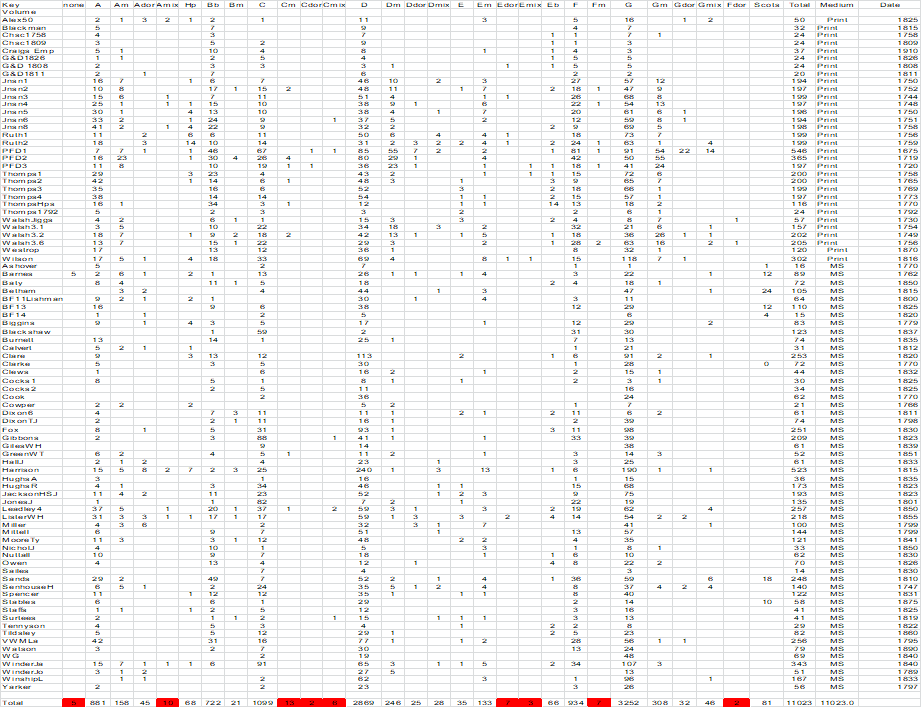
Back to Bits & Bobs
Back to Homepage
Back to List
of Articles
Amassing manuscript and printed historical dance tune
collections into one data set enables us to interrogate it in
various ways. Gender balance of the authors, dance categories,
title choices, which tunes made it into manuscripts or were most
popular, levels of musical literacy, tune construction, and so on,
can all be investigated. To illustrate this I'm going to look at
the choice of keys, an area that is immediately open to
statistical analysis.
When I first started transcribing and editing the Village
Music Project collections in the late nineteen-nineties, I
took the view that since the sources would simply indicate the
number of sharps and flats required, with no mention of mode, as
all written notation still does, unlike computer music notation
programs, then all that was justified in order to reproduce for
the modern reader the information in the source was to nominate
any key that could display the requisite number of sharps or
flats, for example B flat major as a key that would display two
flats. After all, there was no question at the time of our
"intervening" by suggesting that G minor might sometimes be more
suitable, as that was the business of harmonisation, and we were
about conveying the information contained in the manuscript,
nothing more.
As we began to reach the point where there was enough material to start to draw some conclusions from it, I realised that a question that could easily be settled would be the topic of what were the dominant keys and modes in historical English dance music. After all, it is not infrequently asserted for example that A major is the natural key for fiddlers, or that the reason D and G major are so common now at the expense of other keys is because melodeons in D/G have driven the other keys away.
I realised that by using computer transcription programs, since
it is a prerequisite to actually specify key and mode, and by
being lazy and reaching for the nearest approximation, I was
unwittingly making a significant, and potentially misleading,
editorial intervention. Since then I have been going through
the VMP back catalogue, reviewing all 11,000+ tunes, attempting to
get our work to more accurately indicate keys and modes.
The keys and modes have been determined using a combination of scale and tonal centre. Every tune has at least one, and it's usually possible to be fairly objective in determining what it is. Though a lot more could be said I'll restrict myself to the following -- It is not always easy to describe in absolute terms the scale using the conventional church modes; the tune may modulate, or it may have extra accidentals. This is especially noticeable in the earlier collections and becomes so again in the 19thC. Tunes don't have to be describable in terms of conventional modes, it's just that they generally can be.
As a melody line player this has involved a bit of a learning
curve! The whole business of modes can rapidly get very involved
(see for instance this
discussion on Reddit, accessed 24/10/2017)
but for our purposes within English dance music you will see in
due course that the modes most used, with only a very, very few
exceptions, are the Ionian (the modern Major), the Mixolydian
(like the Ionian/Major but with a minor 7th, considered to be
another "major" scale), the Aeolian (the Natural Minor, which has
a flattened third), and the Dorian ( a minor key like the Aeolian,
but with a sharpened sixth). There is also what has come to be
known as The Bagpipe Mode (or HP = Highland Pipes, not to be
confused with HP = Hornpipe!), where the tune alternates between
more than one tonal centre and mode.
The size of the sample is over 11,000 tunes. There were some keys that had so few representatives that in order to keep the charts as brief as possible I have discounted them as statistically insignificant. The excluded keys were Amix (10 tunes), Cmin (13 tunes), Cdor (2 tunes), Cmix (6 tunes), Edor (7 tunes), Emix (3 tunes), Fmin (7 tunes), Fdor (2 tunes)
I entered the data into a Microsoft Excel spreadsheet

There is a column for Scots tunes, but I have since abandoned that
particular line of enquiry. If you click HERE it will open as an excel
file in HTML form. You will be able to navigate as if it were an
Excel file by clicking on the tags across the bottom of the
spreadsheet, but you won't be able to edit it.
From the spreadsheet I have then been able to produce a bar chart
for each collection, which you should be able to access from the
datasheets in the link, showing both the total numbers of tunes in
each key and the percentages of tunes in each key.
For example, here's one for the Rev. Robert Harrison MS, showing what percentage of tunes there are in each key
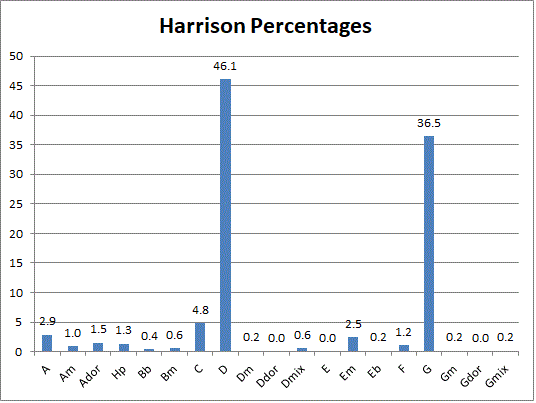
and here's a
similar one for John Johnson Vol 2 (1750) Choice Collection of
Favorite (200) Country Dances.
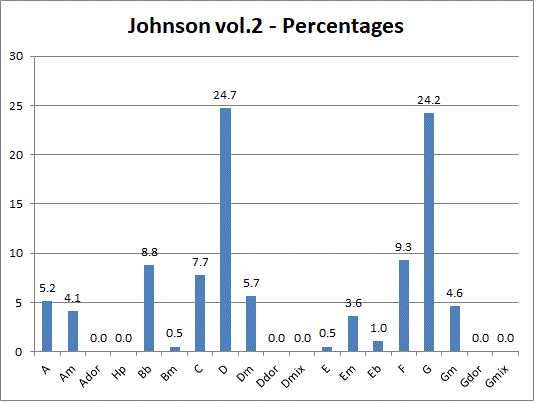
I can utilise the main spreadsheet in a number of ways. For instance I can aggregate all the information onto one chart to give all the key percentages. It isn't very legible but as a graphic it illustrates well the variation between sources.
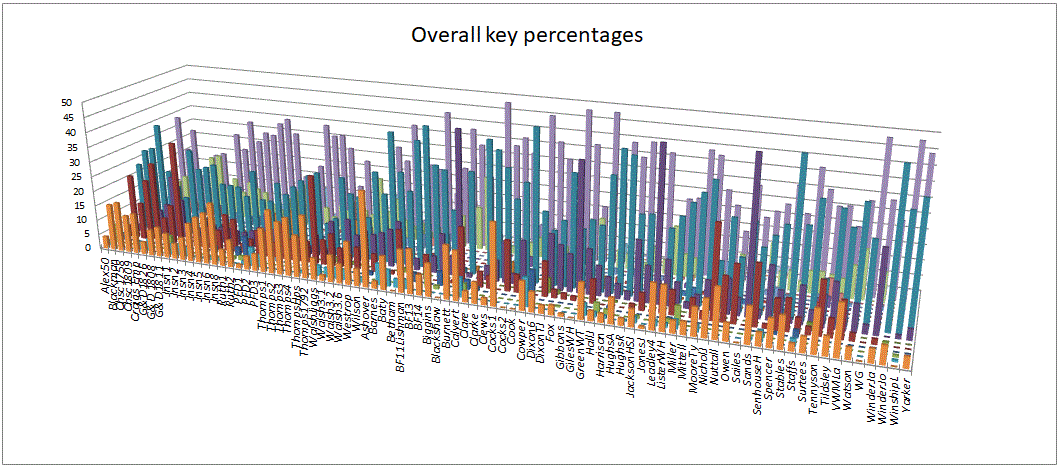
Easier on the eye, here
is the total percentage of tunes in each key of all the sources
combined - all 11,000 tunes!
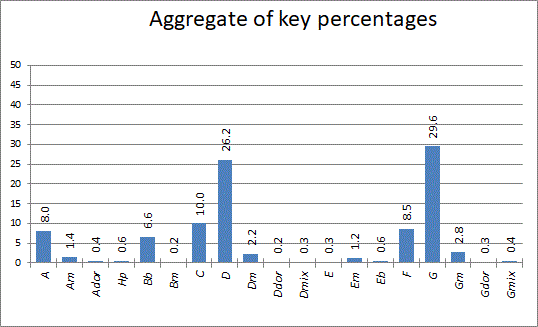
It can be clearly seen that keys D and G major predominate, in order as follows:-
G major 29.5%
D major 26%
C major 10%
F major 8.5%
A major 8%
Bb major 6.5%
G minor 3%
D minor 2%
A minor 1.5%
E minor 1.2%
The Major keys added up to 89.2%, the Minor keys to 7.8%, the Dorian keys only added up to 0.9%, and the Mixolydian keys to 0.7%, Bagpipe 0.6%, plus a small error rounding up and down and a small number of tunes either undetermined or otherwise discounted for various reasons.
As an aside, the heavy use of tunes in C,F, and G major in some manuscripts is usually the sign of an early C clarinet player or some such, as in BLACKSHAW,James MS, 1837, UK Shropshire.
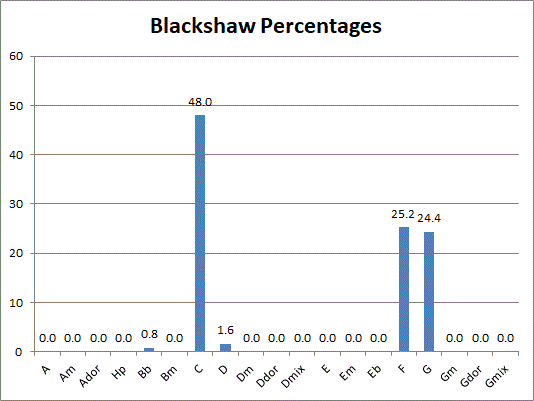
This bias for the moment is too laborious to eliminate, and though
it may have skewed the data a little it still doesn't overturn the
dominance of the G and D Major keys.
So far I've talked about the Manuscripts and the Printed books
lumped together.
But here are the manuscripts compared with the printed sources.
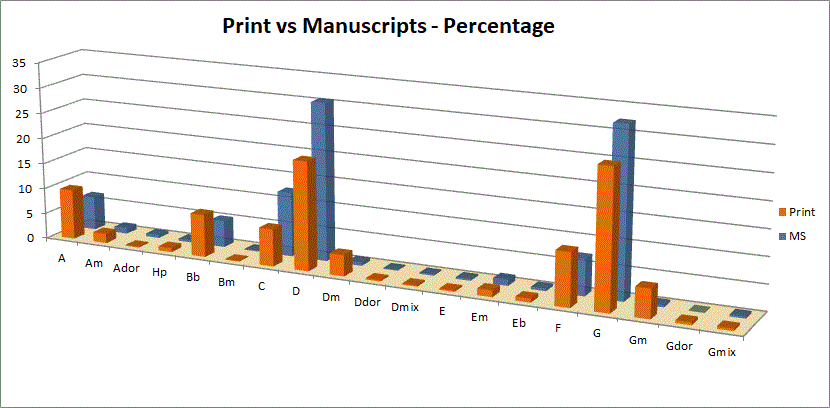
It can be seen that there are more in D and G major in the
manuscripts, and more in Am,Bb,Dm,F,Gm in the printed works.
A comparison can also be made for the (vaguely) northern vs
southern manuscripts
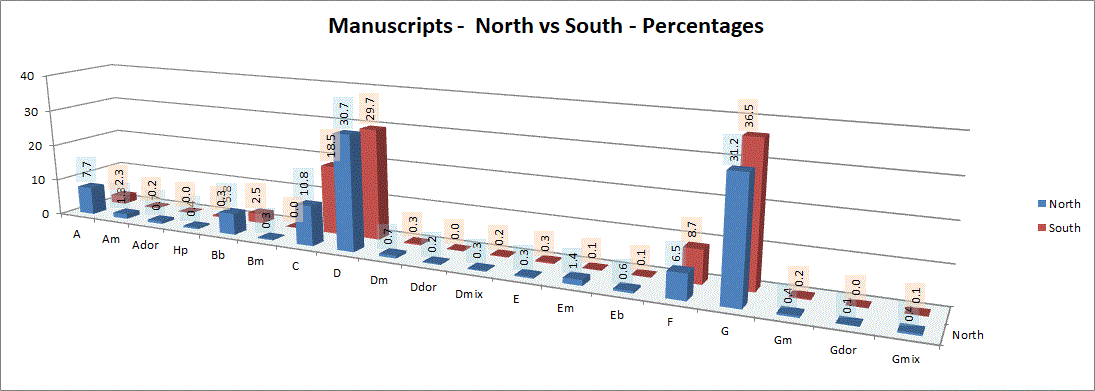
The southern manuscripts have more in CFG, the northern have more in A,Bb, Am,Em, Gmix etc.; though surprisingly the figures for the Bagpipe mode (HP in this graph) are more similar. This is an instance where it may be worth investigating the influence of clarinet manuscripts potentially favouring CFG, even though D is manageable on the instrument.
And here are early printed books, compared in 30 year samples
with late. The earlier books are at the front.
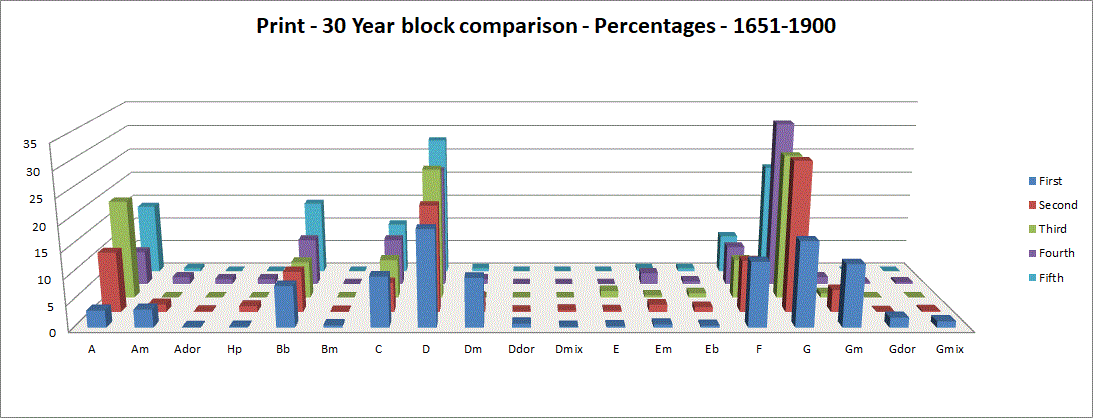
There are many more Amin, Dmin, Gmin and Gdorian in the earlier
sources, which may possibly be explained by who was musically
literate, and therefore potential customers, at that period,
rather than by what was the norm in the world at large, but that
is merely my speculation at the moment.
And again for the Early manuscripts (at the front) versus late
manuscripts.
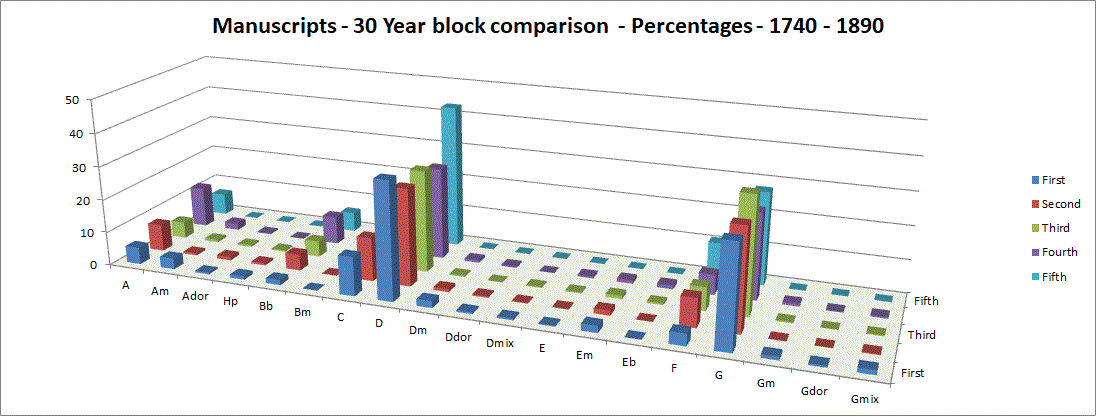
It can be seen from these graphs that the earlier sources have different graphs to the later, the manuscripts differ from the printed books, and so on. This is all no big surprise, but here I've been able to quantify it, and perhaps provoke further questions.
Furthermore, within the simple observation that there are overall
preferences for certain keys and modes, it is also evident
from the data, though I've not shown it here, that between
outwardly similar manuscripts in terms of region, period, social
class or occupation, there is nevertheless some variation,
reflecting the fact that each musician, though sharing a common
culture, was an individual on their own personal development of
interests and skills.
Chris Partington, 27/10/17
Back to List
of Articles
Back to Bits & Bobs
Back to Homepage